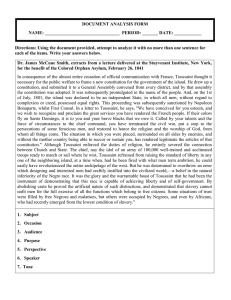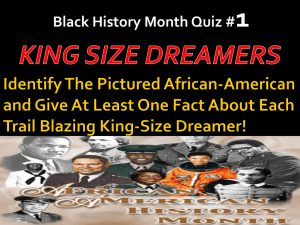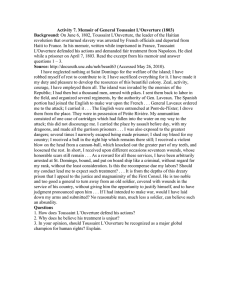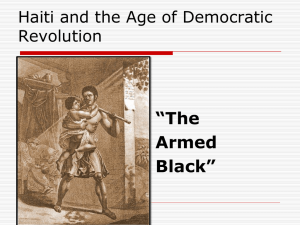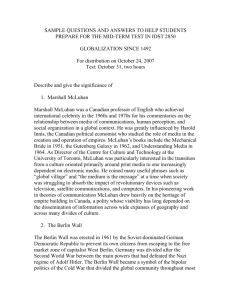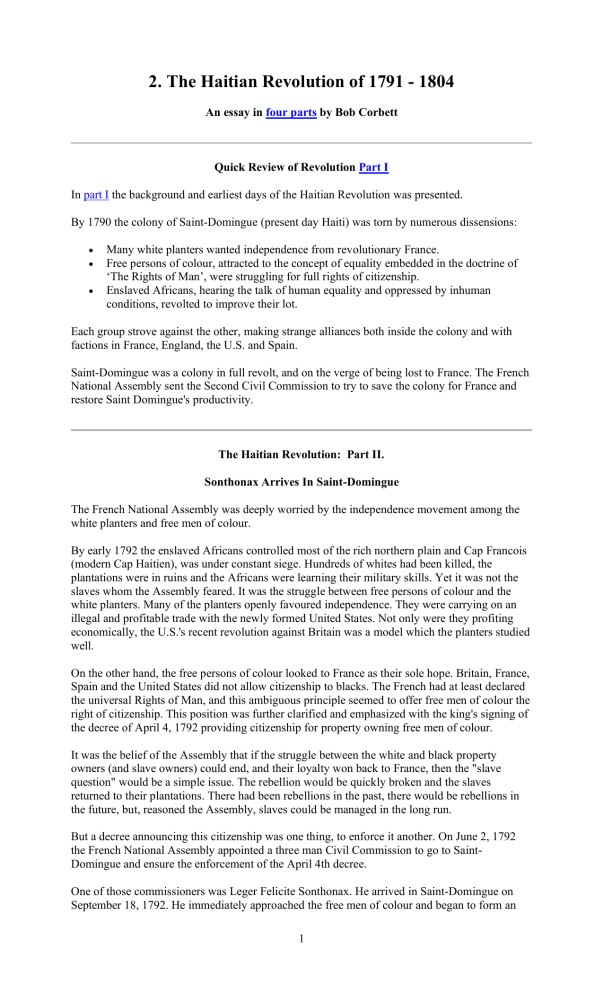
2. The Haitian Revolution of 1791 - 1804 An essay in four parts by Bob Corbett Quick Review of Revolution Part I In part I the background and earliest days of the Haitian Revolution was presented. By 1790 the colony of Saint-Domingue (present day Haiti) was torn by numerous dissensions: • • • Many white planters wanted independence from revolutionary France. Free persons of colour, attracted to the concept of equality embedded in the doctrine of ‘The Rights of Man’, were struggling for full rights of citizenship. Enslaved Africans, hearing the talk of human equality and oppressed by inhuman conditions, revolted to improve their lot. Each group strove against the other, making strange alliances both inside the colony and with factions in France, England, the U.S. and Spain. Saint-Domingue was a colony in full revolt, and on the verge of being lost to France. The French National Assembly sent the Second Civil Commission to try to save the colony for France and restore Saint Domingue's productivity. The Haitian Revolution: Part II. Sonthonax Arrives In Saint-Domingue The French National Assembly was deeply worried by the independence movement among the white planters and free men of colour. By early 1792 the enslaved Africans controlled most of the rich northern plain and Cap Francois (modern Cap Haitien), was under constant siege. Hundreds of whites had been killed, the plantations were in ruins and the Africans were learning their military skills. Yet it was not the slaves whom the Assembly feared. It was the struggle between free persons of colour and the white planters. Many of the planters openly favoured independence. They were carrying on an illegal and profitable trade with the newly formed United States. Not only were they profiting economically, the U.S.'s recent revolution against Britain was a model which the planters studied well. On the other hand, the free persons of colour looked to France as their sole hope. Britain, France, Spain and the United States did not allow citizenship to blacks. The French had at least declared the universal Rights of Man, and this ambiguous principle seemed to offer free men of colour the right of citizenship. This position was further clarified and emphasized with the king's signing of the decree of April 4, 1792 providing citizenship for property owning free men of colour. It was the belief of the Assembly that if the struggle between the white and black property owners (and slave owners) could end, and their loyalty won back to France, then the "slave question" would be a simple issue. The rebellion would be quickly broken and the slaves returned to their plantations. There had been rebellions in the past, there would be rebellions in the future, but, reasoned the Assembly, slaves could be managed in the long run. But a decree announcing this citizenship was one thing, to enforce it another. On June 2, 1792 the French National Assembly appointed a three man Civil Commission to go to SaintDomingue and ensure the enforcement of the April 4th decree. One of those commissioners was Leger Felicite Sonthonax. He arrived in Saint-Domingue on September 18, 1792. He immediately approached the free men of colour and began to form an 1 alliance, promising them that he was the king's representative who would ensure their citizenship. In record time Sonthonax won over the free men of colour, who united with loyal French troops to fight a dual battle: struggling to defeat the radical independence-minded whites, and to pacify the slaves. Within four months Sonthonax had achieved his three major goals: • • • He had pacified, or at least contained, the slave rebellion. He had defeated the primary white resistance. He had held the colony for France. It seemed as if Sonthonax had achieved his mission and could soon return home to France in glory, but for the devastating month of February 1793. First, France declared war on Britain. This war radically changed Sonthonax' situation. Not only did the superior British navy cut off Sonthonax' supply line to France, but the British soon invaded Saint- Domingue, completely unravelling Sonthonax' three short-lived ‘achievements.’ Secondly, in that same month, Louis XVI was guillotined and France became a republic without a king. One immediate effect of this execution was to provide new grounds for resistance among the white planters. Many remained supporters of independence, and they welcomed the British invasion. But others, believing that the problem was the Revolution in France, became royalists, believing that if only a strong king could be put back in place, then everything could return to the old patterns and they would regain their positions of power and privilege in Saint-Domingue. It is interesting to note that this was exactly the aim of Napoleon when he invaded ten years later. Toussaint L’Ouverture and the Slave Rebellion The primary black generals in the earliest days of the slave rebellion were Jean-Francois, Biassou and Jeannot. Jeannot was executed by Jean-Francois and Biassou for excessive cruelty. Shortly after the 1791 uprising, Toussaint L’Ouverture, a former slave who was over forty years old, joined the camp of the rebels as a medical officer. Toussaint practiced herbal and African healing, but unlike most such healers, he was not a Voodoo houngan. However, Toussaint did not remain a medical officer for long. His ability to organize, train and lead men became immediately apparent. Toussaint rose from his position of aide-de-camp to become a general, first fighting under Biassou, and then a general of his own troops. By January 1793 Sonthonax had contained the slave revolt. Negotiations were going on to end the rebellion and for the officers to force their troops to return to their respective plantations. The deal was that some 300 officers would receive freedom and a pardon for their war crimes. The negotiations dragged on, but seemed near completion when the execution of Louis XVI became known. After that event the African officers, especially Toussaint, did not trust the French. They turned to the eastern portion of the island and made an alliance with Spain, who was also at war with France. As Toussaint told Sonthonax, "We cannot conform to the will of the Nation because from the beginning of the world we have executed the will of a King. We have lost the King of France, but we are esteemed by the King of Spain, who bestows rewards upon us and ceases not to give us succour. Consequently we are unable to acknowledge you, the Commissioners, before you have found a King." February 1793 was an extremely bad month for Sonthonax! From having seemingly defeated the independence-minded colonists and containing the slaves and nearly arriving at an understanding which would have ended the rebellion completely, he suddenly had a much graver situation facing him. • • • • The colonists split into independence and royalist factions, now had foreign support, and re-opened their struggle against the April decree, and against Revolutionary France's jurisdiction. The slaves had gone over to the Spanish and were being armed and supplied so that they could attack the French in Saint-Domingue. Sonthonax was faced with invasion from British forces out of Jamaica and had to prepare the defence of the colony. Given the gravity of the situation facing France in Europe and given the power of the British navy in the Caribbean, he could not count on any reinforcements or supplies from France. Truly, Sonthonax' world had come crashing down. 2 Sonthonax Frees All Slaves The Preliminary Stage Sonthonax and the other commissioners realized the British would probably attack SaintDomingue, as would the Spanish and their Saint-Domingue slave army. They began to prepare their defences as best they could. However, they were immediately betrayed from within. General Galbaud, a Frenchman, had been left in charge of Cap Francois while Sonthonax joined the other commissioners to prepare the defences of Port-au-Prince. Galbaud, himself a land owner, conspired with the planters to deport the commissioners and to work with the British to return the ancient regime, negating the citizenship of free men of colour. Sonthonax learned of this and returned to Le Cap with a large force of free men of colour. They surprised Galbaud and he seemingly agreed to return to France. However, he convinced 3000 sailors and French troops to fight with him and the battle was joined on June 20, 1793. It looked as though Galbaud's forces would triumph. Sonthonax took the ultimate plunge. He offered freedom and the rights of French citizenship to 15,000 slaves, part of the slave army encamped just outside Le Cap, if they would fight for France and the commissioners. They accepted and Galbaud was quickly defeated. Sonthonax, now faced with 15,000 new citizens, had a problem. Most of these men had wives and children who were still enslaved. Thus, in short order he also freed the entire families of the new French soldiers. August 23, 1793: Sonthonax' Emancipation The engines of emancipation had been set in motion. Sonthonax had long protested that he came to Saint-Domingue to defend the free persons of colour. He had explicitly stated that he did not intend to free the slaves. However, the Galbaud affair had forced him to free 30,000 to 40,000 people to protect his position. Now he was in a major bind. The white planters and petit blancs were totally outraged. Even his allies, the free persons of colour, were appalled. They were mainly slave holding property owners. They did not want any more slaves freed. Yet Sonthonax knew his time was running short. The British were preparing to invade and the Spanish were training, arming and supplying a large slave army in Santo Domingo. Sonthonax' position was difficult. There was no hope of reinforcements or even supplies from France. The European war precluded that. How could he possibly save the colony for France? The slaves seemed his only hope. There were 500,000 of them. Toussaint, Jean-Francois and Biassou had a well-armed, well-trained army in Santo Domingo. Other slaves were not armed or trained, but their sheer numbers might provide some defence. Would they fight to defend France? Would they fight to defend their freedom? It was a gamble Sonthonax felt he had to take. On August 29, 1793 Sonthonax unilaterally decreed the emancipation of slavery in SaintDomingue. Robert Stein, Sonthonax' biographer, calls this "...the most radical step of the Haitian Revolution and perhaps even of the French Revolution." But, would the slaves respond? Would the gamble pay off? Sonthonax could only wait and see. The British Campaign Begins Sonthonax was right to expect the British to invade. Saint-Domingue had been the richest colony in the Caribbean. Since the British navy controlled access to the Caribbean, Saint-Domingue seemed easy pickings. British General Cuyler assured British officials in London that he had "no apprehension of our successes in the West Indies." On September 19, 1793 the British landed at Jeremie. They were welcomed by the white property owners, who had already signed a secret accommodation with Britain. In exchange for their support, Saint-Domingue would become a British colony. Slavery would be reinstated, people of colour would be stripped of citizenship, and the conditions of Britain's economic policies would favour the colonists more than did France's exclusif. 3 By June 4, 1794 the British had captured Port-au-Prince and held most of the port towns from St. Nicholas in the north to Jeremie at the southern tip. It looked as though the French forces, with little support from Saint- Domingue’s landowners, could not hold out against the Spanish supported British onslaught. The Volte-Face of Toussaint L’Ouverture Like Stein, one may well regard Sonthonax' freeing of the slaves as the most significant event of this period. Nonetheless, the volte-face, the changing sides, of Toussaint L’Ouverture, had the most immediate practical effect. Republican France's position in Saint-Domingue was pushed to the wall. The British held many port towns and the white planters were mainly in the British camp. The bulk of the slaves under arms were with the Spanish. However, France's enemies were not without their own problems. France was prohibited from supplying Sonthonax and the commissioners by the British fleet and the press of the war in Europe. But, that same war left the British without supplies and reinforcements too. The British army, suffering desperately from yellow fever, and seemingly ignored by London, was quickly being depleted and suffered from extremely poor morale. The Spanish were in grave difficulty in the European war, and were declining as a force to be reckoned with. Finally, the free persons of colour, despising Sonthonax' freeing of the slaves, were nonetheless becoming convinced that neither the British nor Spanish were any real hope for them. More and more of the people of colour were returning to the French banner. The war in Saint-Domingue was going badly for the French, but, despite the British gains in the south, the situation was improving, though it was grave and dangerous. Clearly the turning point in this war and in all Haitian history was the return to the French side of Toussaint L’Ouverture and eventually all his black and mulatto forces. But when and why did Toussaint return? This is a very difficult question and scholars are not in agreement. I find myself persuaded by the arguments of David Geggus who fixes the date of the volte-face at around May 6, 1794. The reasons for the turn are not quite certain, but Geggus argues it was a collage of several factors: • • • • Toussaint was sincerely fighting for general emancipation of slavery, and Sonthonax' emancipation weighed on him. By May 6th it is unlikely that Toussaint knew that the French National Assembly had already ratified Sonthonax' move on Feb. 4th. However, Toussaint had a close relationship with the French General Laveaux, and seems to have already been negotiating with him to come over to the French side. Laveaux may well have convinced him that France was sincere in the emancipation. Toussaint was having serious problems with the Spanish. They did not trust him, perhaps knowing of his discussions with Laveaux. Toussaint knew that the Spanish position in Europe was not strong and perhaps sensed that he was fighting for a losing side. Toussaint was having serious problems with both Jean-Francois and Biassou and wanted to break with them, and become superior to them. Whatever the full complement of reasons, Toussaint made his change and that made all the difference. His army fought a guerrilla war and he was known for his lightening attacks, covering territory at seemingly impossible speeds. He attacked both Jean-Francois and Biassou, his former associates and defeated them. He harassed the British, though he could not dislodge them from the coastal towns they held. One chronicler says: "He disappears; he has flown as if by magic. Now he reappears again where he is least expected. He seems to be ubiquitous. One never knows where his army is, what it subsists on, how he manages his supplies and his treasury. He, on the other hand, seems perfectly informed concerning everything that goes on in the enemy camp." The Spanish soon ended their war. The French defeated them in Europe and signed a peace treaty on July 22, 1795. A significant part of the treaty was that Spain ceded Santo Domingo to the French, though it was some time before Toussaint's army actually took over the eastern part of the island. The Spanish black armies were disbanded, though many came over to Toussaint. Jean-Francois retired to Spain and Biassou went to Florida. By this time Toussaint had become an important part of the French forces and was promoted to brigadier general. 4 Toussaint's Rise to Power and the End of Foreign Occupation With the turn of Toussaint L’Ouverture and many former slaves, and the withdrawal of the Spanish, the war took on lesser proportions. Britain, too, had developed grave difficulties of maintaining morale and troop strength. Then, when a serious rebellion broke out in Jamaica, the British ceased fighting an offensive war and settled in to trying to hold the main strongholds of the coastal towns. An internal power struggle developed. Toussaint shared the same rank as did Andre Rigaud, mulatto general of the south and Villatte, another mulatto who was at Cap Francois. The two mulattos were suspicious of Toussaint and dreaded his rise to power. They plotted against both the French and Toussaint planning to consolidate their own positions. Their first move came against General Laveaux, head of the French forces and governor of the colony. The plan was for Villatte to capture and depose Laveaux. Then Rigaud would become governor general and Villatte would be his chief aide. On March 20, 1796, Laveaux was captured at Le Cap by Villatte. Toussaint immediately moved from Gonaives and marched on Cap Francois with 10,000 men. The mulatto forces capitulated and released Laveaux on March 22. Villatte fled into exile. Laveaux rewarded Toussaint on April 1st by making him lieutenant governor, giving him much greater freedom within the military, and pledging he would do nothing without consulting Toussaint. This declaration was tantamount to making Toussaint the effective governor and commander in chief. Toussaint responded, "After God, Laveaux." The mulattos had suffered a terrible defeat. The triumph over the mulattos was only days old when Sonthonax returned to Haiti as head of the third Civil Commission. Toussaint recognized that both Sonthonax and his friend Laveaux stood in his way. He began a clever political campaign that left him the key power in SaintDomingue. Toussaint managed to engineer an election in which both Sonthonax and Laveaux were "elected" to return to France to represent Saint-Domingue to the National Assembly. Laveaux recognized that Toussaint was now dominant and he quietly returned to France on October 13, 1796. It was nearly another year before Toussaint could manoeuvre Sonthonax out of Saint-Domingue. Sonthonax was his own worst enemy during this struggle. Having thrown in his lot with the blacks and against both the whites and free persons of colour, he decided to put Rigaud down. He sent a force against Rigaud, which was defeated. However, Toussaint was then assured that Rigaud would not oppose his move against Sonthonax. Sonthonax further damaged his own case by allowing French privateers to operate against American shipping. This even hurt black commerce, and most people were sympathetic to Toussaint's pro-American trade stance. After trying several times to force Sonthonax out by power of persuasion, Toussaint finally used armed force and on August 27, 1797 Sonthonax sailed for France, never to return. This left Toussaint governor general and commander in chief of Saint- Domingue with only the British and Rigaud standing in the way of his absolute dominance. During 1796 and 1797 the British had once more opened their offensive campaign in SaintDomingue. However, the increasing death toll in the war, particularly from yellow fever, the increasing cost, opposition in London and the constant nagging guerrilla war against them, brought the British to a standstill. While Parliament refused to recall them altogether, the British army was left to fend on its own. However, it still held most of the seacoast from Jeremie to St. Nicholas, including Port-au-Prince. In early 1798 Toussaint began a massive campaign against the British. On March 21st General Thomas Maitland arrived to oversee the British forces. At almost the same time Theodore Hedouville, a French special agent, arrived in Santo Domingo. Hedouville was there to gently ease Toussaint out of power. The French National Assembly had become worried by the extent of his power and what seemed to be his tendencies toward independence from France. This was underlined by Toussaint's willingness to reopen trade with the Americans and to prohibit French privateering against them from Saint Domingan waters. Hedouville hoped to use Andre Rigaud and building on the existing distrust and enmity between the two, drive them into open conflict. 5 Maitland, on his part, saw a way to use this situation to his advantage. It was clear that the British were finished in Saint-Domingue. By posing as an ally of Toussaint, Maitland could get the best conditions for withdrawal and perhaps even arrange a secret convention of trade relations with Toussaint, whom he believed would prevail. At the same time he sought Toussaint's guarantee that he would not invade Jamaica. Maitland further promised aid of the British navy if Toussaint wanted to declare independence. Maitland's strategy was to drive a wedge between Hedouville and Toussaint, insuring the weakening of French authority, and increasing the likelihood of British gain. Toussaint wasn't ready to declare independence from France, but he did know what Hedouville was up to. As soon as the British had left Saint- Domingue forever in October 1798, Toussaint began his move against Hedouville. He was able to convince the masses that Hedouville was actually there to unseat Toussaint and to reinstall slavery, which actually may well have been the case. At any rate, a mob stormed the city of Cap Francois and Hedouville and his forces embarked for France. Toussaint had been the primary force for four years, between May 1794 and October 1798. In that time he had driven the British out of Saint- Domingue, overseen the retreat of the Spanish, ousted all genuine French authority and become commander in chief and governor general of the Saint- Domingue. As he saw it, there were only three challenges left to his supreme authority. • • • The belief of the National Assembly that he was not loyal to France. Andre Rigaud and the mulatto forces. The existence of Spanish Santo Domingo next door. Toussaint took up the challenge of these three threats. This is the second in a four part series of articles on the Haitian Revolution written by Bob Corbett. Go to Part 1 Go to Part 3 Go to Part 4 Please, comments and corrections are welcomed! corbetre@webster.edu REVOLUTIONARY WAR Art, Music, & Dance Mailing List Book Reviews Miscellaneous Topics MAIN HAITI PAGE Film Notes on Books HOME Bob Corbett corbetre@webster.edu 6 History People to People Library Literature Voodoo
